911d586738cbe544507e8695121a9538.ppt
- Количество слайдов: 50

http: //heande. pyrkilo. fi National Public Health Institute, Finland Open risk assessment Lecture 1: Introduction www. ktl. fi Jouni Tuomisto KTL, Finland 1

http: //heande. pyrkilo. fi National Public Health Institute, Finland www. ktl. fi Outline • What are the challenges of the current risk assessment? • Why risk assessment is needed in the future? • What is needed from the new risk assessment? • Can it work? • Practical examples and links 2

http: //heande. pyrkilo. fi National Public Health Institute, Finland www. ktl. fi Disclaimer • Open (risk) assessment is not officially accepted method or thinking anywhere • It has been developed in KTL within a risk research group lead by J. T. • The idea is actively promoted within several EU-funded research projects (Intarese, Heimtsa, Beneris, Hiwate, Hitea) without official success so far • The idea is promoted in practice by running a website for open assessments 3

http: //heande. pyrkilo. fi www. ktl. fi • • • 4 National Public Health Institute, Finland What are the challenges of the current risk assessment? Limited area of application Lack of flexibility and breadth Inefficiency and slowliness of the process Deliberate biases towards "safety" Communication problems Lack of acceptability among stakeholders

http: //heande. pyrkilo. fi National Public Health Institute, Finland Limited area of application • Only a few chemical groups require pre-market RA: – Pesticides, drugs, food additives – This will improve with Reach but not disappear • RA not triggered for many important "natural" exposures: www. ktl. fi – Traditional foods and food items vs. GMO – Environmental exposures: moldy buildings vs. PM • Often limited to situations where the release links to someone's economic interest • Who can and should trigger a RA? 5

http: //heande. pyrkilo. fi National Public Health Institute, Finland Lack of flexibility and breadth • Each discipline has developed an own framework – – – www. ktl. fi Scientific opinions on food issues by EFSA Chemical risk assessment for pesticides Safety assessment for drugs Life cycle assessment for consumer products Environmental impact assessments for major construction sites – "Not tested with animals" for cosmetics • Is this just cultural diversity or a problem of administration and a health hazard? 6

http: //heande. pyrkilo. fi National Public Health Institute, Finland Importance of boundaries • Risk-benefit analysis of farmed salmon (Tuomisto et al, www. ktl. fi Science 2004) 7

http: //heande. pyrkilo. fi National Public Health Institute, Finland Inefficiency and slowliness of the process • Inefficiency: it takes a lot of person-months to complete – A lot of expensive expert work – The risk assessments done are not available for others in a useful format • A description of work in a form of a report may be available, but the actual work, i. e. , data, calculations, reasoning, and detailed results are not. www. ktl. fi • Slowliness: it takes a lot of calendar months to complete – The process has data collection, systematic literature searches, public hearings, reviews, scientific advisory panels… – The dioxin RA by the U. S. EPA: 8 • a draft was published 1996 • a second draft was published 2000

http: //heande. pyrkilo. fi National Public Health Institute, Finland www. ktl. fi Major chemical reviews in IRIS 9

http: //heande. pyrkilo. fi National Public Health Institute, Finland Deliberate biases towards "safety" • Approaches to minimize the false negative error www. ktl. fi – Reference dose=NOAEL/UFa/UFi – BMDL: lower CI of the benchmark dose – LMS (q 1*): linearized multistage • Poorly known chemicals are perceived worse than well known major hazards • The problems tend to fall out of YOUR mandate (to others to solve (or ignore)) 10

http: //heande. pyrkilo. fi • On whose side does the problem salmon Risk-benefit analysis of farmed fall? (Tuomisto et al, www. ktl. fi Science 2004) 11 National Public Health Institute, Finland

http: //heande. pyrkilo. fi National Public Health Institute, Finland www. ktl. fi Why is risk assessment needed in the future? • The real problems in the future are NOT those that the current risk assessment was developed for: – Drugs – Pesticides – Food additives • It is needed because it would be nice to do something useful for the real risks of the future. The risks that are so complex that no single expert is an expert in all parts of the issue. These risks are such as. . . 14

http: //heande. pyrkilo. fi National Public Health Institute, Finland Climate change www. ktl. fi • Uppsala glacier, Patagonia, Argentina: above, in 1928 and below, in 2004. 15

http: //heande. pyrkilo. fi National Public Health Institute, Finland www. ktl. fi Fine particle air pollution 16

http: //heande. pyrkilo. fi National Public Health Institute, Finland www. ktl. fi Energy efficiency 17

http: //heande. pyrkilo. fi National Public Health Institute, Finland www. ktl. fi Urban living environment 18

http: //heande. pyrkilo. fi National Public Health Institute, Finland www. ktl. fi Drinking water amount and quality 19

http: //heande. pyrkilo. fi National Public Health Institute, Finland www. ktl. fi Biodiversity 20

http: //heande. pyrkilo. fi National Public Health Institute, Finland www. ktl. fi Population growth 21

http: //heande. pyrkilo. fi National Public Health Institute, Finland www. ktl. fi Global environmental taxes 22

http: //heande. pyrkilo. fi National Public Health Institute, Finland What is needed from the new assessment? of administration Limited area of Adoptable by any area or policy-making Lack of flexibility and breadth Fully scalable to very simple and very complex questions Inefficiency and slowliness of the process Deliberate biases towards "safety" Info structured & directly reusable Delegation, non-experts included Routines automated Best estimates (incl uncertainty) used Communication problems www. ktl. fi application Everything available for clarification questions Lack of acceptability among stakeholders Stakeholders must have a say on everything in advance Value judgements included in the assessment 23

http: //heande. pyrkilo. fi National Public Health Institute, Finland www. ktl. fi Paradigm shift • Thomas Kuhn (19221996) • Science progresses in a regular way until too many faults are identified in the current paradigm. Then, there is a period of extraordinary science, which leads into a shift of paradigm 24

http: //heande. pyrkilo. fi National Public Health Institute, Finland www. ktl. fi Pyrkilo • Jouni Tuomisto (1997): It is possible to develop such a system, pyrkilo, that transforms ideas, information, and people's opinions into a description that tends to converge towards scientific validity. • The assessments that are produced using the pyrkilo method we call open assessments. • After several years of work, the Heande 25 website was opened Sept 2006.

http: //heande. pyrkilo. fi National Public Health Institute, Finland Open assessment • The objectives: – Find solutions to ALL the challenges at the same time – Systematize and "industrialize" the risk assessment – Maintain high scientific quality www. ktl. fi • The current situation with open assessment: there are suggested methods to all challenges listed previously – Many of the suggestions have not been tested in practice – Not everything will probably work • However, there is already a critical mass of 26

http: //heande. pyrkilo. fi National Public Health Institute, Finland What is the acceptability of the idea of open assessment? • Poll (informal, based on observations of several audiences): www. ktl. fi – 30 % think it is a stupid idea – 50 % think it cannot work – 15 % find it interesting, but… – 5 % are fond of the idea • In which category do you fall in? 27

http: //heande. pyrkilo. fi National Public Health Institute, Finland www. ktl. fi Assessment: Gasbus 28

http: //heande. pyrkilo. fi National Public Health Institute, Finland Assessments in practice • They look like Wikipedia articles • They are written in much the same way • Substance is on the main page – Research question – Definition: how to find an answer – Result www. ktl. fi • Discussion about the substance is on a separate discussion page – Discussion can be free or structured 29

http: //heande. pyrkilo. fi National Public Health Institute, Finland Open assessment • The research question for the (pyrkilo) method: – "How can scientific information and value judgements be organised for societal decisionmaking in such a way that open participation is possible? " www. ktl. fi • Full range of development – – 30 a new ontological foundation strictly object-oriented approach a new structure for information objects traditional RA methods for processing information, but organised in a more systematic way – tools that enable open collaboration

http: //heande. pyrkilo. fi National Public Health Institute, Finland Highlights of theory behind • The basic principles are – Open participation at all phases of the assessment – Requirement of scientific method (openness to scientific critique) at all phases – Reusability of information from one assessment to another www. ktl. fi • A uniform information structure is used: 31 – Assessment: specific information need for a policy decision – Variable: a truthful description of a particular part of reality; it is independent of assessments given its scope. – Both objects have 4 attributes: name, scope (research question), definition (how to answer), and

http: //heande. pyrkilo. fi National Public Health Institute, Finland Assessments are performed openly in the Internet • Parts needed to run open assessments www. ktl. fi – Web pages with method descriptions for the assessors (Guidebook) – Web pages about useful data (Resource Centre) – Web pages about actual assessments • Descriptions of assessments and models used (Warehouse) • Actual models (Toolbox) • Results of assessments in a uniform structure (Result database) 32 – Web pages for collaborative work on assessments (Collaborative workspace)

http: //heande. pyrkilo. fi National Public Health Institute, Finland Quality control • Is quality control possible if pages are available for all to contribute? • Our first thoughts (no experience yet, because work is practically within research projects) www. ktl. fi – Pages can be freely added and edited – Advanced pages are protected from direct edits • Then, the edits are made through an open discussion on a separate page; results are transferred to the actual page 33 – Very important pages go through a peer

http: //heande. pyrkilo. fi National Public Health Institute, Finland Can open assessment work? www. ktl. fi • I am convinced it can work • I am convinced the remaining problems can be solved • However, this does not mean that it WILL succeed, at least in our time… 34

http: //heande. pyrkilo. fi National Public Health Institute, Finland Leonardo's parachute ca. 1500 www. ktl. fi – first applications in 20 th century 35

http: //heande. pyrkilo. fi National Public Health Institute, Finland Bayes' theorem ca. 1750 • Reverend Thomas Bayes published the Bayes' theorem in ca. 1750 www. ktl. fi – first real applications in 1960's 36

http: //heande. pyrkilo. fi National Public Health Institute, Finland www. ktl. fi What is the potential for mass collaboration in environmental health risks? • 6, 000, 000 people in the world • 1, 000, 000 of them have access to Internet • 10, 000 of them are seriously thinking about environmental and/or health problems: ”What could I do? ” • 1, 000 of them can speak English • 100, 000 of them have a good background for the work (e. g. university degree) • 10, 000 of them are willing to spend 1 37 h/week on this

http: //heande. pyrkilo. fi National Public Health Institute, Finland www. ktl. fi How would the world look like with full-scale open assessments? • The turnover of scientific information speeds up • Scientific information is easily available in a readily useful form always, from anywhere, and in your own language. • Time is spent on assessing solutions to problems, not on talking about assessing them. • People start to respond to the politicians suggesting something stupid: ”Did you 38
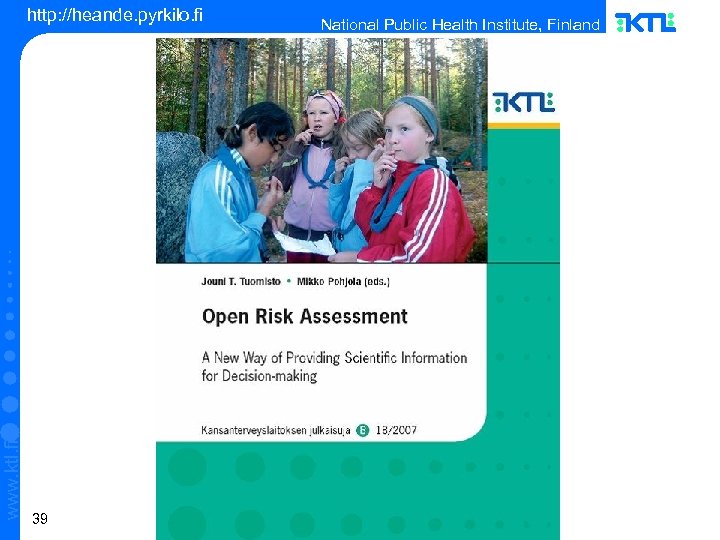
http: //heande. pyrkilo. fi National Public Health Institute, Finland www. ktl. fi The ORA report 39

http: //heande. pyrkilo. fi National Public Health Institute, Finland www. ktl. fi Falsification 40 • Karl Popper (1902 -1994) • Science consists of statements (theories) that can be falsified • Science is an evolutionary process where poor theories are falsified • The current knowledge consists of those theories that have not (yet) been falsified
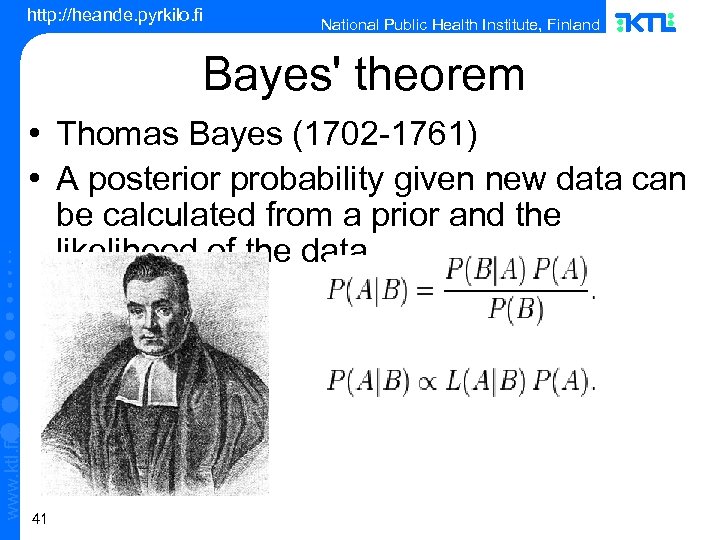
http: //heande. pyrkilo. fi National Public Health Institute, Finland Bayes' theorem www. ktl. fi • Thomas Bayes (1702 -1761) • A posterior probability given new data can be calculated from a prior and the likelihood of the data 41

http: //heande. pyrkilo. fi National Public Health Institute, Finland Decision theory www. ktl. fi • Howard Raiffa • Decision analysis is a rational method for making decisions. In addition, the use of subjective (Bayesian) probabilities in decision analysis should be promoted. 42
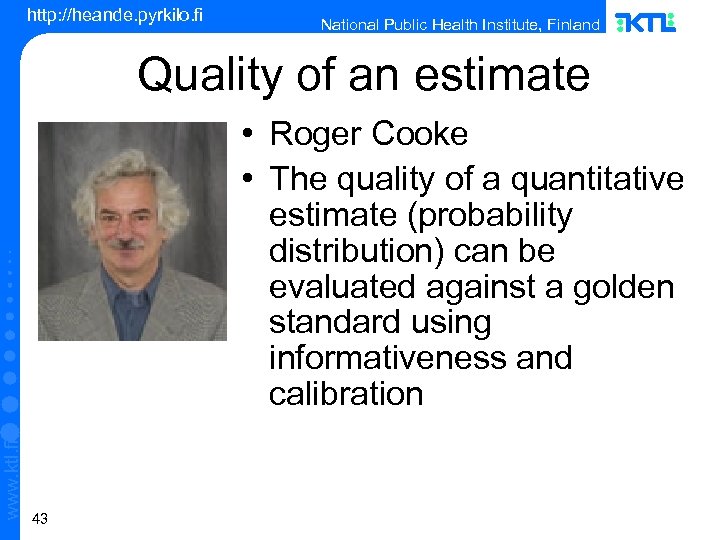
http: //heande. pyrkilo. fi National Public Health Institute, Finland Quality of an estimate www. ktl. fi • Roger Cooke • The quality of a quantitative estimate (probability distribution) can be evaluated against a golden standard using informativeness and calibration 43
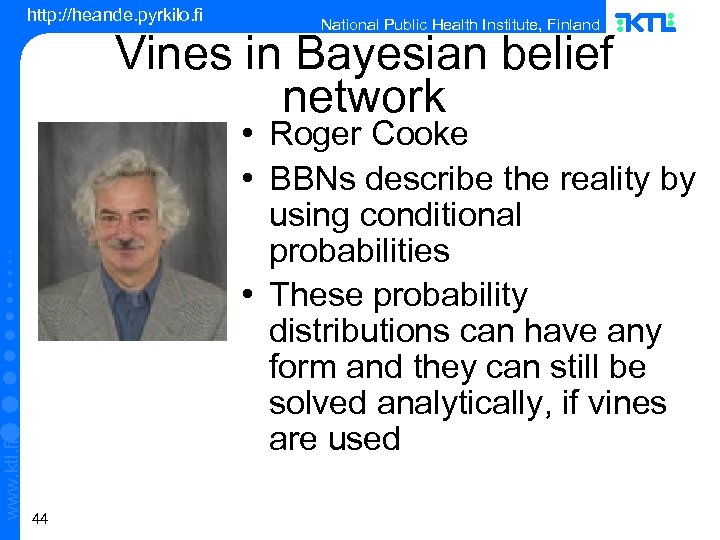
http: //heande. pyrkilo. fi National Public Health Institute, Finland www. ktl. fi Vines in Bayesian belief network • Roger Cooke • BBNs describe the reality by using conditional probabilities • These probability distributions can have any form and they can still be solved analytically, if vines are used 44
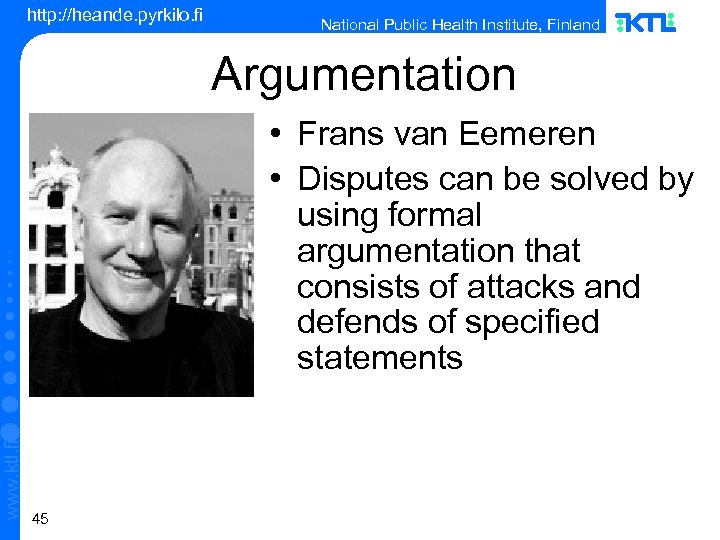
http: //heande. pyrkilo. fi National Public Health Institute, Finland Argumentation www. ktl. fi • Frans van Eemeren • Disputes can be solved by using formal argumentation that consists of attacks and defends of specified statements 45
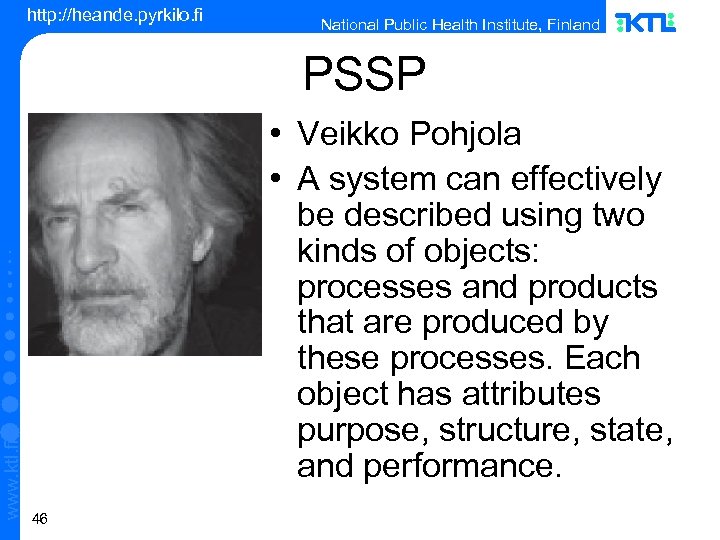
http: //heande. pyrkilo. fi National Public Health Institute, Finland www. ktl. fi PSSP • Veikko Pohjola • A system can effectively be described using two kinds of objects: processes and products that are produced by these processes. Each object has attributes purpose, structure, state, and performance. 46

http: //heande. pyrkilo. fi National Public Health Institute, Finland www. ktl. fi Wisdom of crowds • James Surowiecki • A group of people is likely to outperform an individual expert, if they can use individual knowledge, act independently and in a decentralized way, and their opinions are effectively aggregated 47
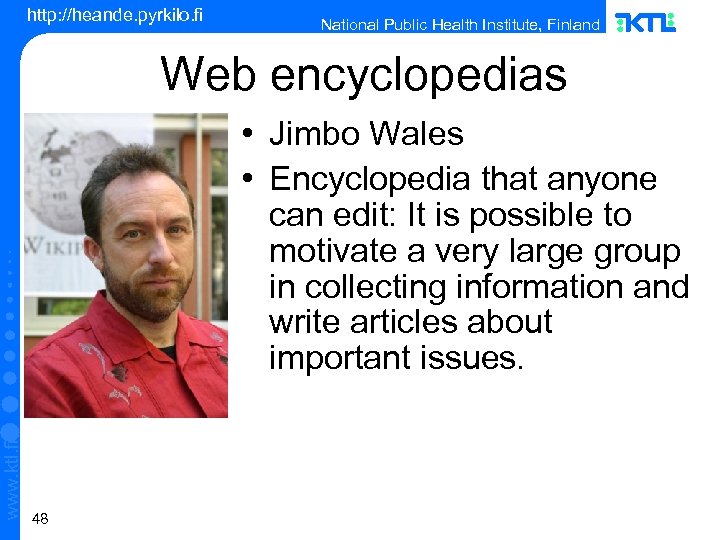
http: //heande. pyrkilo. fi National Public Health Institute, Finland Web encyclopedias www. ktl. fi • Jimbo Wales • Encyclopedia that anyone can edit: It is possible to motivate a very large group in collecting information and write articles about important issues. 48

http: //heande. pyrkilo. fi National Public Health Institute, Finland www. ktl. fi Mass collaboration 49 • Don Tapscott, Anthony Williams • A large group of unorganised people are able to produce complex artefacts, if the product is information or culture, the work can be chopped into bite-size pieces, and the pieces can be effectively synthesised.
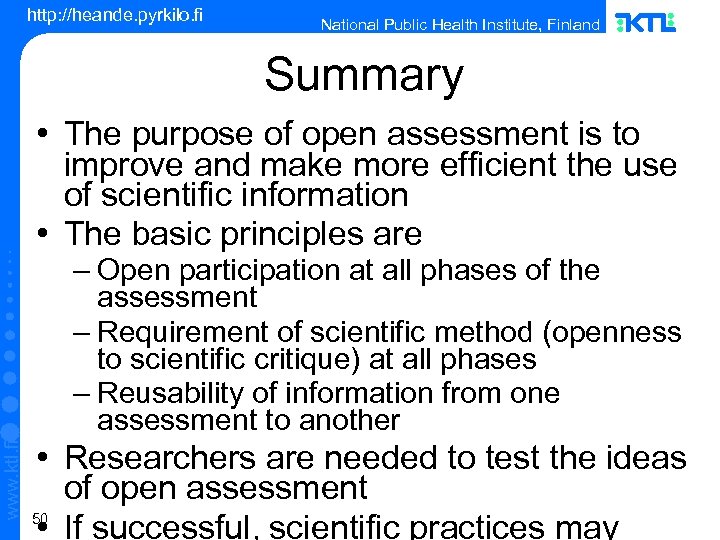
http: //heande. pyrkilo. fi National Public Health Institute, Finland Summary • The purpose of open assessment is to improve and make more efficient the use of scientific information • The basic principles are www. ktl. fi – Open participation at all phases of the assessment – Requirement of scientific method (openness to scientific critique) at all phases – Reusability of information from one assessment to another • Researchers are needed to test the ideas of open assessment 50 • If successful, scientific practices may
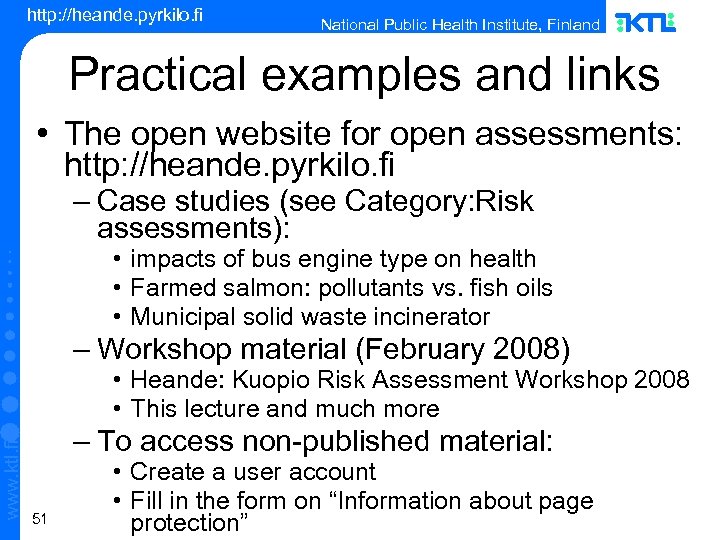
http: //heande. pyrkilo. fi National Public Health Institute, Finland Practical examples and links • The open website for open assessments: http: //heande. pyrkilo. fi – Case studies (see Category: Risk assessments): • impacts of bus engine type on health • Farmed salmon: pollutants vs. fish oils • Municipal solid waste incinerator – Workshop material (February 2008) www. ktl. fi • Heande: Kuopio Risk Assessment Workshop 2008 • This lecture and much more – To access non-published material: 51 • Create a user account • Fill in the form on “Information about page protection”
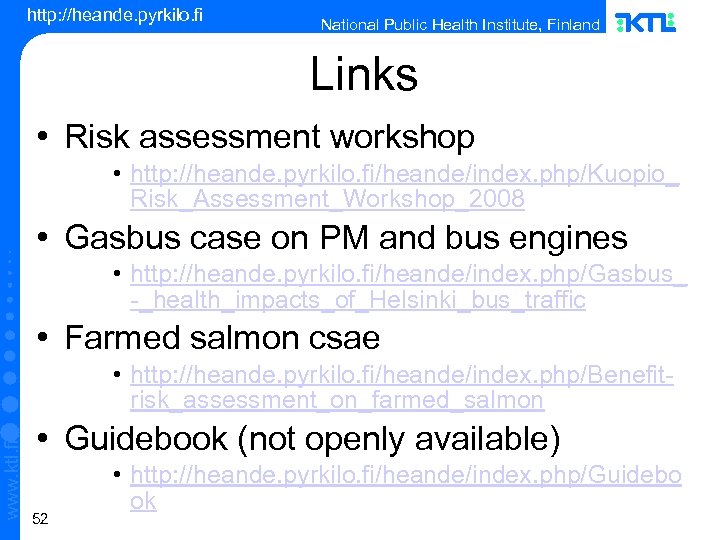
http: //heande. pyrkilo. fi National Public Health Institute, Finland Links • Risk assessment workshop • http: //heande. pyrkilo. fi/heande/index. php/Kuopio_ Risk_Assessment_Workshop_2008 • Gasbus case on PM and bus engines • http: //heande. pyrkilo. fi/heande/index. php/Gasbus_ -_health_impacts_of_Helsinki_bus_traffic • Farmed salmon csae www. ktl. fi • http: //heande. pyrkilo. fi/heande/index. php/Benefitrisk_assessment_on_farmed_salmon • Guidebook (not openly available) 52 • http: //heande. pyrkilo. fi/heande/index. php/Guidebo ok
911d586738cbe544507e8695121a9538.ppt